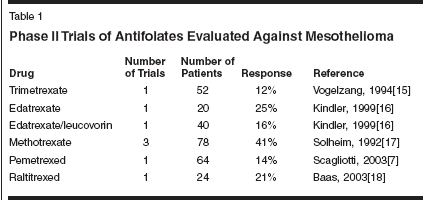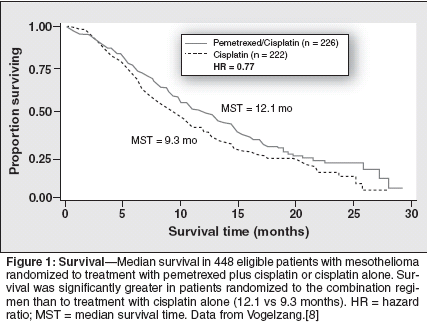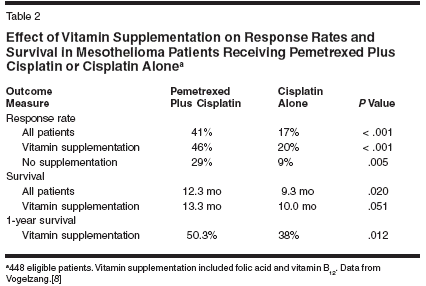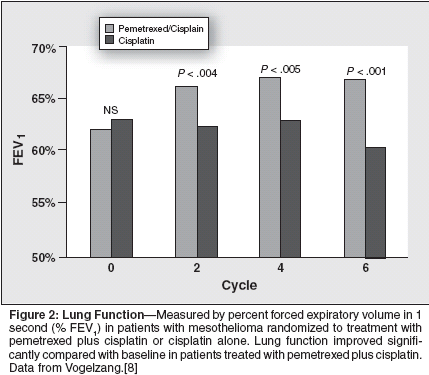The Emerging Role of Pemetrexed for the Treatment of Malignant Mesothelioma
Malignant mesothelioma is a devastating disease with an onset 20to 60 years after exposure to asbestos. Although most cytotoxic agentshave been evaluated for the treatment of mesothelioma, few single agentshave consistently yielded response rates above 20%. Antimetabolitesare the most active drugs against mesothelioma, and of these, theantifolate group is the most widely studied and effective. Pemetrexed(Alimta), a new antifolate, may be more active because of its differentmechanism of action. Several clinical trials have evaluated pemetrexedalone and in combination with a platinum agent for patients with malignantmesothelioma. A pivotal phase III trial has demonstrated thatcombination chemotherapy with pemetrexed and cisplatin improvessurvival, response rate, pulmonary function, and quality of life comparedwith single-agent cisplatin. Additional trials are evaluatingpemetrexed in the neoadjuvant setting and in combination with othercytotoxic and targeted agents.
ABSTRACT: Malignant mesothelioma is a devastating disease with an onset 20to 60 years after exposure to asbestos. Although most cytotoxic agentshave been evaluated for the treatment of mesothelioma, few single agentshave consistently yielded response rates above 20%. Antimetabolitesare the most active drugs against mesothelioma, and of these, theantifolate group is the most widely studied and effective. Pemetrexed(Alimta), a new antifolate, may be more active because of its differentmechanism of action. Several clinical trials have evaluated pemetrexedalone and in combination with a platinum agent for patients with malignantmesothelioma. A pivotal phase III trial has demonstrated thatcombination chemotherapy with pemetrexed and cisplatin improvessurvival, response rate, pulmonary function, and quality of life comparedwith single-agent cisplatin. Additional trials are evaluatingpemetrexed in the neoadjuvant setting and in combination with othercytotoxic and targeted agents.
Malignant mesothelioma is adevastating malignancy thataffects approximately 2,500Americans and 5,000 Western Europeanseach year. It develops 20 to 60years after asbestos exposure. Sinceworkplace regulations limiting asbestosexposure were instituted earlier inthe United States, the incidence ofmesothelioma in the United States isbelieved to have peaked in the year2000, while the peak incidence in Europeis not expected to occur until2018 to 2025. Men are more commonlyaffected, reflecting occupationalexposure. The median age of onsetcontinues to rise. The median survivalof patients with mesothelioma rangesfrom 6 to 15 months.[1]Numerous cytotoxic agents havebeen evaluated for the treatment ofmesothelioma. Few drugs have consistentlyyielded response rates above20%, which has led to considerabletherapeutic nihilism. Antimetabolitesare among the most active agentsagainst mesothelioma; the antifolatesare the most active and most widelystudied group of antimetabolites (seeTable 1).Pemetrexed (Alimta), a new antifolateagent, may be more active thanother antifolates against mesotheliomafor several reasons. Pemetrexedtargets more than one locus: thymidylatesynthase, dihydrofolate reductase,and glycinamide ribonucleotideformyltransferase. A newly describedcell membrane transporter found inmesothelioma is highly specific forpemetrexed.[2] The folate receptoralpha, which may be involved in pemetrexedtransport, is highly activatedin mesothelioma.[3] Methylthioadenosinephosphorylase (MTAP) is deletedin 66% of mesotheliomas, whichmay make these tumors particularlysensitive to inhibitors of de novo purinesynthesis.[4]Completed Clinical Trials WithPemetrexedSeveral phase I, II, and III trialshave evaluated pemetrexed alone orin combination with a platinum agentin patients with malignant mesothelioma.Phase I Trials
Pemetrexed has been evaluated incombination with a platinum agent intwo phase I trials; vitamin supplementationwas not utilized in eitherstudy. Thoedtmann and colleaguesinvestigated the combination of pemetrexedand cisplatin in 54 patients with advanced solid tumors. Two cohortswere studied: in cohort 1, bothdrugs were given on day 1, usingstarting doses of pemetrexed and cisplatinof 300 and 60 mg/m2, respectively.In cohort 2, pemetrexed at 500or 600 mg/m2 was administered onday 1, and cisplatin at 75 mg/m2 wasgiven on day 2.[5] Dose-limiting toxicityincluded neutropenic fever. Partialresponses were observed in 5 ofthe 11 evaluable patients withmesothelioma.



Hughes and colleagues evaluatedpemetrexed in combination with carboplatin(Paraplatin) in a phase I trialperformed exclusively in patients withmalignant mesothelioma. Twentysevenpatients were treated on fivedose levels, ranging from pemetrexedat 400 mg/m2 followed by carboplatinat an area under the concentration-time curve (AUC) of 4, to pemetrexedat 500 mg/m2 and carboplatinat AUC 6; both agents were givenevery 21 days.[6] The maximumtolerated dose was pemetrexed500 mg/m2 and carboplatin AUC 6;the recommended phase II dose waspemetrexed 500 mg/m2 and carboplatinAUC 5. Toxicities were principallyhematologic, including grade3/4 neutropenia in 70% of patients,leukopenia in 48%, and thrombocytopeniain 52%. Partial responseswere observed in 32% of the patientsin this phase I trial. The median survivalwas 451 days, and 70% of patientsexperienced symptomaticimprovement.Phase II Trial
Single-agent pemetrexed has beenevaluated in a multicenter phase IItrial in 64 chemotherapy-naive patientswith malignant pleural mesothelioma.Patients received pemetrexed500 mg/m2 intravenously over 10 minutesevery 21 days.[7] Forty-three patientsreceived vitamin supplementationwith folic acid and vitamin B12.Partial responses were observed in14% of patients, which is within theexpected range for an antifolate agentin this disease (see Table 1). Mediansurvival was 10.7 months; 1-year survivalwas 47.8%. Twenty-three percentof patients experienced grade3/4 neutropenia.

Phase III Trial
The largest clinical trial ever performedin patients with malignantmesothelioma was a pivotal, singleblind,placebo-controlled, internationalphase III trial which randomized456 previously untreated patients withmalignant pleural mesothelioma toeither pemetrexed at 500 mg/m2 followedby cisplatin at 75 mg/m2, orplacebo followed by cisplatin at 75mg/m2; both regimens were administeredintravenously every 21 days.[8]Vitamin supplementation with folateand vitamin B12 was initiated in December1999, after 117 patients hadbeen enrolled, in order to reduce severepemetrexed-related toxicity. Patientswere stratified by performancestatus, histology, gender, white bloodcell count, measurability of disease,and baseline homocysteine level. Theprimary objective was survival; secondaryobjectives included responserate, time to progression, toxicity, clinicalbenefit, and pulmonary function.

The trial was well balanced withrespect to baseline patient characteristics,including age, sex, performancestatus, histology, and stage. A total of226 patients were randomized to thecombination arm, and 222 to singleagentcisplatin. The response rate wassignificantly higher in the pemetrexed/cisplatin arm compared with cisplatinalone (41% vs 17%; P < .001). Survivalwas significantly improved withcombination chemotherapy: patientstreated with pemetrexed/cisplatin hada median survival of 12.1 months com-pared with 9.3 months for cisplatinalone (P = .020; Figure 1). Time toprogression also was improved withpemetrexed/cisplatin (5.7 vs 3.9months, P = .001).Vitamin supplementation with folicacid and vitamin B12 improved responserates and survival in bothtreatment arms (Table 2). Vitamin supplementationreduced the incidenceof several grade 3/4 toxicities in thepemetrexed/cisplatin arm, includingdrug-related death, neutropenia, febrileneutropenia, thrombocytopenia,vomiting, stomatitis, and diarrhea (Table3).[8] The median number of chemotherapycycles delivered was alsogreater for patients on either arm whoreceived vitamin supplementation.Treatment with pemetrexed pluscisplatin was associated with significantimprovement in lung function asmeasured by FEV1 (Figure 2) and vitalcapacity.[8] Tumor response correlatedwith lung function as measuredby pulmonary function tests. Patientswho had either a partial response orstable disease had better lung functionthan patients with progressive disease,regardless of treatment arm.[9]Most (93%) patients had three ormore symptoms at study entry.[10].Using the Lung Cancer SymptomScale for Mesothelioma (LCSS-Meso)instrument, Gralla and colleagues reportedthat global assessment of qualityof life (P = .012) and symptomdistress (P = .009) improved significantlywith combination therapy at18 weeks. Patients treated with thecombination regimen experienced significantimprovement (P < .001) inthoracic symptoms of pain, dyspnea,and cough as well as improvement ingeneral symptoms including fatigue(P = .010), anorexia (P = .017), andactivity level (P = .059).A Cox multiple regression analysisof the association between posttrialchemotherapy administration andsurvival found that second-line chemotherapycorrelated with increasedsurvival (P < .01).[11] Second-linechemotherapy was administered to 38% of patients in the pemetrexedplus cisplatin arm and 48% of patientsin the single-agent cisplatin arm.The most commonly administeredchemotherapy drugs were gemcitabine(Gemzar), vinorelbine (Navelbine),and doxorubicin. Althoughfewer patients in the combinationtreatment arm received second-linechemotherapy, these patients still hada significantly longer survival comparedwith those treated with cisplatinalone (P = .02, log rank).Univariate and multivariate analysesconfirmed that patients treated withpemetrexed plus cisplatin had significantlylonger survival than patientstreated with single-agent cisplatin.Vitamin supplementation, good Karnofskyperformance status, early-stagedisease, and epithelial histology werealso associated with increased survival.Decreased survival was associatedwith elevated leukocyte counts andincreased cystathionine.[12]Ongoing Clinical TrialsWith PemetrexedSeveral ongoing phase II trials areevaluating pemetrexed in mesotheliomapatients. Janne and colleagues arestudying the combintion of gemcitabineand pemetrexed in a multicenterphase II trial in patients with peritonealas well as pleural mesothelioma.[13] This is a logical combinationto evaluate, since gemcitabine andpemetrexed are synergistic in vitro,and the combination demonstrated significantactivity in a phase I trial.[14]Fifty-three chemonaive patients receivedgemcitabine at 1,250 mg/m2on days 1 and 8 and pemetrexed at500 mg/m2 on day 8. Grade 3/4 neutropeniadeveloped in 33% of cycles.A response rate of 20% was observedin the first 34 evaluable patients. Analternate schedule of gemcitabine at1,250 mg/m2 on days 1 and 8 andpemetrexed at 500 mg/m2 given onday 1 is currently being explored.The role of the pemetrexed pluscisplatin combination in neoadjuvanttreatment is currently being exploredin a multicenter US study. Most mesotheliomapatients who receive extrapleuralpneumonectomy developlocal recurrence, while many patients who undergo extrapleural pneumonectomyfollowed by high-dosehemithoracic radiation therapy developsystemic recurrence. It is hypothesizedthat administering activesystemic chemotherapy prior to surgeryand radiation could facilitate resectionand decrease recurrence.The primary objective of this studyis pathological complete response rate(H0 ≥ 1% vs Ha 6%). Secondary endpoints include disease-free and overallsurvival, response rate, toxicity,and pattern of relapse. Laboratory parametersbeing evaluated includethymidylate synthase, dihydrofolatereductase, glycinamide ribonucleotideformyltransferase, folylpolyglutamatesynthetase, dihydropyrimidine dehydrogenase,reduced folate carrier, alphafolate receptor, and excision repaircross-complementation group 1(ERCC1). Eligible patients will haveInternational Mesothelioma InterestGroup stage I to III disease, and adequatecardiopulmonary, bone marrow,hepatic, and renal function. Patientswill receive 4 cycles of pemetrexedand cisplatin followed by extrapleuralpneumonectomy 3 to 8 weeks aftercompletion of chemotherapy, andhemithoracic radiation (54 Gy) 4 to 8weeks following surgery. This is thefirst multicenter trial of multimodalitytreatment for mesothelioma everperformed in the United States.ConclusionPemetrexed plus cisplatin is thefirst chemotherapy combination thathas been demonstrated to improvesurvival in patients with malignantmesothelioma. Pemetrexed is thus avery important addition to the armamentariumof chemotherapy agents forthis disease, and further study is warranted.Ongoing studies are evaluatingpemetrexed in combination with gemcitabineand in the neoadjuvant setting;planned trials will assess pemetrexedin combination with other cytotoxic andtargeted agents for this disease.
Disclosures:
Dr. Kindler has receivedresearch support from and acted as aconsultant and participated in speakers’ bureausfor Lilly Oncology.
References:
1.
Kindler HL, Vogelzang NJ: Mesothelioma,in Vokes EE, Golomb HM (eds): OncologicTherapies, 2nd ed. Berlin, Springer-Verlag, 2003.
2.
Wang Y, Zhao R, Chattopadhyay S, et al:A novel folate transport activity in human mesotheliomacell lines with high affinity andspecificity for the new-generation antifolate,pemetrexed. Cancer Res 62(22):6434-6437,2002.
3.
Bueno R, Appasani K, Mercer H, et al:The alpha folate receptor is highly activated inmalignant pleural mesothelioma. J ThoracCardiovasc Surg 121(2):225-233, 2001.
4.
Illei PB, Rusch VW, Zakowski MF, et al:Homozygous deletion of CDKN2A andcodeletion of the methylthioadenosine phosphorylasegene in the majority of pleural mesotheliomas.Clin Cancer Res 9:2108-2113,2003.
5.
Thoedtmann R, Depenbrock H, DumezH, et al: Clinical and pharmacokinetic phase Istudy of multitargeted antifolate (LY231514)in combination with cisplatin. J Clin Oncol17:3009-3016, 1999.
6.
Hughes A, Calvert P, Azzabi A, et al: PhaseI clinical and pharmacokinetics study ofpemetrexed and carboplatin in patients withmalignant pleural mesothelioma. J Clin Oncol20:3533-3544, 2002.
7.
Scagliotti GV, Shin DM, Kindler HL, etal: Phase II study of pemetrexed with and withoutfolic acid and vitamin B12 as front-linetherapy in malignant pleural mesothelioma. JClin Oncol 21:1556-1561, 2003.
8.
Vogelzang NJ, Rusthoven JJ, SymanowskiJ, et al: Phase III study of pemetrexed in combinationwith cisplatin versus cisplatin alonein patients with malignant pleural mesothelioma.J Clin Oncol 21:2636-2644, 2003.
9.
Paoletti P, Pistolesi M, Rusthoven JJ, etal: Correlation of pulmonary function tests withbest tumor response status: Results from thephase III study of pemetrexed + cisplatin vs.cisplatin in malignant pleural mesothelioma(abstract 2651). Proc Am Soc Clin Oncol22:659, 2003.
10.
Gralla RJ, Hollen PJ, Liepa AM, et al.Improving quality of life in patients with malignantpleural mesothelioma: Results of therandomized pemetrexed + cisplatin vs. cisplatintrial using the LCSS-meso instrument (abstract2496). Proc Am Soc Clin Oncol 22:621, 2003.
11.
Manegold C, Symanowski J, GatzemeierU, et al: Secondary (post-study) chemotherapyin the phase III study of pemetrexed + cisplatinvs. cisplatin in malignant pleural mesotheliomais associated with longer survival (abstract2684). Proc Am Soc Clin Oncol 22:667, 2003.
12.
Symanowski JT, Rusthoven J, NguyenB, et al: Multiple regression analysis of prognosticvariables for survival from the phase IIIstudy of pemetrexed + cisplatin vs. cisplatin inmalignant pleural mesothelioma (abstract2602). Proc Am Soc Clin Oncol 22:647, 2003.
13.
Janne PA, Obasaju C, Simon G, et al: Aphase 2 clinical trial of pemetrexed plusgemcitabine as front-line chemotherapy forpatients with malignant pleural mesothelioma.Proc Am Soc Clin Oncol 23:626, 2004.
14.
Adjei AA, Erlichman C, Sloan JA, et al:Phase I and pharmacologic study of sequencesof gemcitabine and the multitargeted antifolateagent in patients with advanced solid tumors.J Clin Oncol 18(8):1748-1757, 2000.
15.
Vogelzang NJ, Weissman LB, HerndonJE II, et al: Trimetrexate in malignant mesothelioma:A Cancer and Leukemia Group B phaseII study. J Clin Oncol 12:1436-1442, 1994.
16.
Kindler HL, Belani CP, Herndon JE, etal: Edatrexate (10-ethyl-deaza-aminopterin)(NSC #626715) with or without leucovorin rescuefor malignant mesothelioma: Sequentialphase II trials by the Cancer and LeukemiaGroup B. Cancer 86:1985-1991, 1999.
17.
Solheim, OP, Saeter G, Finnanger AM,et al: High-dose methotrexate in the treatmentof malignant mesothelioma of the pleura. Aphase II study. Br J Cancer 65:956-960, 1992.
18.
Baas P, Ardizzoni A, Grossi F, et al: Theactivity of raltitrexed (Tomudex) in malignantpleural mesothelioma: An EORTC phase IIstudy (08992). Eur J Cancer 39(3):353-357,2003